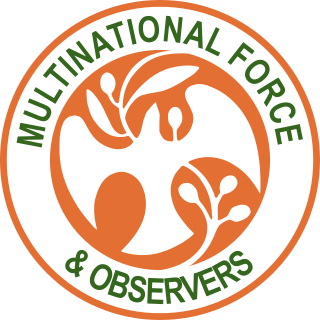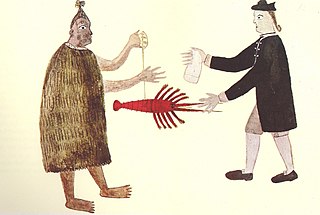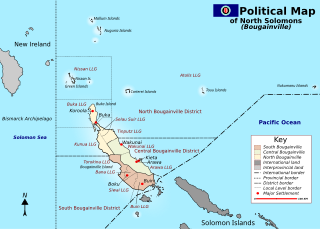Related Research Articles

The Australian Army is the principal land warfare force of Australia, a part of the Australian Defence Force (ADF) along with the Royal Australian Navy and the Royal Australian Air Force. The Army is commanded by the Chief of Army (CA), who is subordinate to the Chief of the Defence Force (CDF) who commands the ADF. The CA is also directly responsible to the Minister for Defence, with the Department of Defence administering the ADF and the Army.

His Majesty's Armed Forces (HMAF) is the military of Tonga. It is composed of three operational components and two support elements.

Bougainville, an autonomous region of Papua New Guinea (PNG), has been inhabited by humans for at least 29,000 years, according to artefacts found in Kilu Cave on Buka Island. The region is named after Bougainville Island, the largest island of the Solomon Islands archipelago, but also contains a number of smaller islands.

The Regional Assistance Mission to Solomon Islands (RAMSI), also known as Operation Helpem Fren, Operation Anode and Operation Rata, was created in 2003 in response to a request for international aid by the Governor-General of Solomon Islands. Helpem Fren means "help a friend" in Solomon Islands Pidgin. The mission officially ended on 30 June 2017.
The Fiji Infantry Regiment is the main combat element of the Republic of Fiji Military Forces. It is a light infantry regiment consisting of six battalions, of which three are regular army and three are Territorial Force. The regiment was formed with the foundation of the Fijian armed forces in 1920, which came under the jurisdiction of New Zealand. The regiment, as it is today, goes back to 1978 following Fiji's independence. The Royal Australian Infantry Corps and Royal New Zealand Infantry Regiment conduct yearly training seminars and exercises with the Fiji Infantry Regiment

The Multinational Force and Observers (MFO) is an international peacekeeping force overseeing the terms of the peace treaty between Egypt and Israel. The MFO generally operates in and around the Sinai peninsula.
The Peace Monitoring Group (PMG) on Bougainville in Papua New Guinea was brought about by the civil unrest on the island in 1989. The PNG government requested the Australian and New Zealand governments to provide a monitoring group to oversee the cease fire on the island. This group was made up of both civilian and defence personnel from Australia, New Zealand, Fiji and Vanuatu. Both sides of the conflict welcomed the group being on Bougainville. This support remained strong throughout the PMG's deployment. The PMG played a role in facilitating the peace process on 30 April 1998 and took over from the New Zealand Truce Monitoring Group which then departed.

The International Force East Timor (INTERFET) was a multinational non-United Nations peacemaking task force, organised and led by Australia in accordance with United Nations resolutions to address the humanitarian and security crisis that took place in East Timor from 1999–2000 until the arrival of UN peacekeepers. INTERFET was commanded by an Australian military officer, Major General Peter Cosgrove.

The military history of New Zealand is an aspect of the history of New Zealand that spans several hundred years. When first settled by Māori almost a millennium ago, there was much land and resources, but war began to break out as the country's carrying capacity was approached. Initially being fought with close range weapons of wood and stone, this continued on and off until Europeans arrived, bringing with them new weapons such as muskets. Colonisation by Britain led to the New Zealand Wars in the 19th century in which settler and imperial troops and their Māori allies fought against other Māori and a handful of Pākehā. In the first half of the 20th century, New Zealanders of all races fought alongside Britain in the Boer War and both World Wars. In the second half of the century and into this century the New Zealand Defence Force has provided token assistance to the United States in several conflicts. New Zealand has also contributed troops extensively to multilateral peacekeeping operations.

HMAS Tobruk was a Landing Ship Heavy (LSH) of the Royal Australian Navy (RAN), based on the design of the Round Table-class of the British Royal Fleet Auxiliary. Planning for the ship began in the 1970s to provide the Australian Army with a permanent sealift capability. She was laid down by Carrington Slipways in 1979, launched in 1980, and commissioned in 1981. She was a multi-purpose, roll-on/roll-off heavy lift ship capable of transporting soldiers, APCs, and tanks, and delivering them to shore via landing craft or directly by beaching.

Operation Morris Dance was an Australian military operation conducted in May 1987 in response to the first of the 1987 Fijian coups d'état.

Following the terrorist attacks of September 11, 2001, several nations took on Al-Qaeda and the Taliban during Operation Enduring Freedom (OEF) in Afghanistan. OEF was the initial combat operations starting on 7 October 2001, in the wake of the 11 September attacks on the United States, and during 2002 and 2003.

United Nations (UN) peacekeeping missions involving Pakistan cover about 70 operations throughout different parts of the world. Pakistan joined the United Nations on 30 September 1947, despite opposition from Afghanistan because of the Durand Line issue. The Pakistan Armed Forces are the third largest contributor of troops towards UN peacekeeping efforts, behind India and Ethiopia.

HMNZS Endeavour (A11) was a fleet oiler for the Royal New Zealand Navy. She was named after James Cook's Bark Endeavour and the third ship in the RNZN to carry that name, though if continuity with the Royal Navy ships of the name HMS Endeavour is considered, she is the twelfth. The previous two ships of the RNZN were Antarctic research support vessels. Endeavour was built in South Korea to a commercial design and commissioned on 8 April 1988, and decommissioned on 15 December 2017.

Australian military involvement in peacekeeping operations has been diverse, and included participation in both United Nations sponsored missions, as well as those as part of ad hoc coalitions. Indeed, Australians have been involved in more conflicts as peacekeepers than as belligerents; however, according to Peter Londey "in comparative international terms, Australia has only been a moderately energetic peacekeeper." To be sure even though Australia has had peacekeepers in the field continuously for 60 years – the first occasion being in Indonesia in 1947, when Australians were among the first group of UN military observers – its commitments have generally been limited, consisting of small numbers of high-level and technical support troops or observers and police. David Horner has noted that the pattern changed with the deployment of 600 engineers to Namibia in 1989–90 as the Australian contribution to UNTAG. From the mid-1990s, Australia has been involved in a series of high-profile operations, deploying significantly large units of combat troops in support of a number of missions including those in Cambodia, Rwanda, Somalia and later in East Timor. Australia has been involved in close to 100 separate missions, involving more than 30,000 personnel and 10 Australians have died during these operations.
Rosemarie Gillespie, also known as Waratah Rose, was an Australian lawyer, human rights activist, author and film producer. She was active in human rights causes in Australia, the USA, Melanesia, the Pacific Islands and the Middle East for more than forty years.

The Official History of Australian Peacekeeping, Humanitarian and Post-Cold War Operations is the official history of Australia's military and civilian involvement in peacekeeping since 1947 as well as military operations in the years after the end of the Cold War. The series is being jointly produced by the Australian War Memorial and Australian National University, with Professor David Horner serving as its general editor. It is planned that the series will comprise six volumes.

The Bougainville conflict, also known as the Bougainville Civil War, was a multi-layered armed conflict fought from 1988 to 1998 in the North Solomons Province of Papua New Guinea (PNG) between PNG and the secessionist forces of the Bougainville Revolutionary Army (BRA), and between the BRA and other armed groups on Bougainville. The conflict was described by Bougainvillean President John Momis as the largest conflict in Oceania since the end of World War II in 1945, with an estimated 15,000–20,000 Bougainvilleans dead, although lower estimates place the toll at around 1,000–2,000.

The logistical support of the multinational International Force East Timor (INTERFET) peacekeeping mission in 1999 and 2000 involved, at its peak, 11,693 personnel from 23 countries. Of these 5,697 were from Australia, making it the largest deployment of Australian forces overseas since the Vietnam War. INTERFET was unusual in that it was led by Australia, casting the country in a wholly unfamiliar role. The logistics and support areas of the Australian Defence Force (ADF) had been subject to deep cuts in the 1990s. The ADF had not anticipated being committed to such a large peacekeeping mission, and was unprepared to support an Australian force projection of this size, much less act as lead nation of an international coalition.

VOEA Pangai (P202) was a Pacific Forum patrol vessel operated by Tonga.
References
- Adams, Rebecca, ed. (2001). Peace on Bougainville: Truce Monitoring Group. Victoria University Press in association with the Centre for Strategic Studies, New Zealand. ISBN 0864734085.
- Breen, Bob (2016). The Good Neighbour: Australian Peace Support Operations in the Pacific Islands, 1980–2006. The Official History of Australian Peacekeeping, Humanitarian and Post-Cold War Operations. V. Port Melbourne, Victoria: Cambridge University Press. ISBN 978-1-107-01971-3.